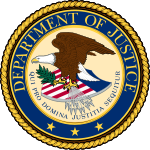United States Marshals Service
| United States Marshals Service | |
| Common name | Marshals Service |
| Abbreviation | USMS |
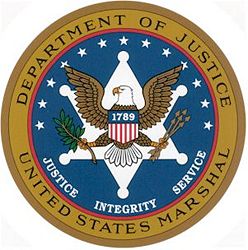 |
|
| Official seal of the US Marshals Service | |
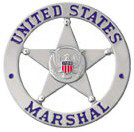 |
|
| United States Marshal's star badge | |
| Agency Overview | |
|---|---|
| Formed | 1789 |
| Legal personality | Governmental agency |
| Jurisdictional Structure | |
| Federal agency | United States |
| Constituting instrument | United States Code, Title 28, Chapter 37 |
| General nature |
|
| Operational Structure | |
| Headquarters | Arlington, Virginia |
| Agency executives |
|
| Parent agency | Department of Justice |
| Website | |
| http://www.usdoj.gov/marshals | |
The United States Marshals Service (USMS) is a United States federal government law enforcement agency within the United States Department of Justice (see ) and is the oldest federal law enforcement agency in the United States.[1]
The USMS is the enforcement arm of the United States federal courts. U.S. Marshals protect court officers and buildings and ensure the effective operation of the judicial system.
Contents |
History
The offices of U.S. Marshals and Deputy Marshals were created by the first Congress in the Judiciary Act of 1789, the same legislation that established the federal judicial system. In a letter to Edmund Randolph, the first United States Attorney General, President George Washington wrote,
- Impressed with a conviction that the due administration of justice is the firmest pillar of good Government, I have considered the first arrangement of the Judicial department as essential to the happiness of our Country, and to the stability of its political system; hence the selection of the fittest characters to expound the law, and dispense justice, has been an invariable object of my anxious concern.
Many of the first U.S. Marshals had already proven themselves in military service during the American Revolution. Among the first marshals were John Adams' son-in-law Congressman William Stephens Smith for the district of New York, another New York district Marshal, Congressman Thomas Morris and Henry Dearborn for the district of Maine.
From the earliest days of the nation, Marshals were permitted to recruit Special Deputies as local hires or as temporary transfers to the Marshals Service from other federal law enforcement agencies. Marshals were also authorized to swear in a posse to assist them in manhunts and other duties on an ad hoc basis. Marshals were given extensive authority to support the federal courts within their judicial districts, and to carry out all lawful orders issued by federal judges, Congress, or the President.
The Marshals and their Deputies served subpoenas, summonses, writs, warrants, and other process issued by the courts, made all the arrests, and handled all federal prisoners. They also disbursed funds as ordered by the courts. Marshals paid the fees and expenses of the court clerks, U.S. Attorneys, jurors, and witnesses. They rented the courtrooms and jail space and hired the bailiffs, criers, and janitors. They made sure the prisoners were present, the jurors were available, and that the witnesses were on time.
When Washington set up his first administration and the first Congress began passing laws, both quickly discovered an inconvenient gap in the constitutional design of the government: It had no provision for a regional administrative structure stretching throughout the country. Both the Congress and the executive branch were housed at the national capital; no agency was established or designated to represent the federal government's interests at the local level. The need for a regional organization quickly became apparent. Congress and the President solved part of the problem by creating specialized agencies, such as customs and revenue collectors, to levy tariffs and taxes, yet there were numerous other jobs that needed to be done. The only officers available to do them were the Marshals and their Deputies.
Thus, the Marshals also provided local representation for the federal government within their districts. They took the national census every decade through 1870. They distributed Presidential proclamations, collected a variety of statistical information on commerce and manufacturing, supplied the names of government employees for the national register, and performed other routine tasks needed for the central government to function effectively. Over the past 200 years, Congress, the President and Governors have also called on the Marshals to carry out unusual or extraordinary missions, such as registering enemy aliens in time of war, sealing the American border against armed expeditions from foreign countries, and at times during the Cold War, swapping spies with the Soviet Union, and also retrieving North Carolina's copy of the Bill of Rights.[2]
Particularly in the American West, individual Deputy Marshals have been seen as legendary heroes in the face of rampant lawlessness (see Famous Marshals, below). Marshals arrested the infamous Dalton Gang in 1893, helped suppress the Pullman Strike in 1894, enforced Prohibition during the 1920s, and have protected American athletes at recent Olympic Games. Marshals protected the refugee boy Elián González before his return to Cuba in 2000, and have protected abortion clinics as required by Federal law. Since 1989, the Marshals Service has been responsible for law enforcement among U.S. personnel in Antarctica, although they are not routinely assigned there.[3]
One of the more onerous jobs the Marshals were tasked with was the recovery of fugitive slaves, as required by the Fugitive Slave Act of 1850. They were also permitted to form a posse and to deputize any person in any community to aid in the recapture of fugitive slaves. Failure to cooperate with a Marshal resulted in a $5000 fine and imprisonment, a stiff penalty for those days. The Oberlin-Wellington Rescue was a celebrated fugitive-slave case involving U.S. marshals. James Batchelder was the second marshal killed in the line of duty. Batchelder, along with others, was preventing the rescue of fugitive slave Anthony Burns in Boston in 1854.

In the 1960s the Marshals were on the front lines of the Civil Rights Movement, mainly providing protection to volunteers. In September 1962, President John F. Kennedy ordered 127 marshals to accompany James Meredith, an African American who wished to register at the segregated University of Mississippi. Their presence on campus provoked riots at the university, requiring President Kennedy to federalize the Mississippi National Guard to pacify the crowd, but the marshals stood their ground, and Meredith successfully registered. Marshals provided continuous protection to Meredith during his first year at "Ole Miss," and Attorney General Robert F. Kennedy later proudly displayed a marshal's dented helmet in his office. U.S. Marshals also protected black schoolchildren integrating public schools in the South. Artist Norman Rockwell's famous painting "The Problem We All Live With" depicted a tiny Ruby Bridges being escorted by four towering U.S. marshals in 1964.
Just as America has changed over the past two centuries, so has its federal justice system – from the original 13 judicial districts, to 94 districts spanning the continent and beyond; and with tens of thousands of federal judges, prosecutors, jurors, witnesses, and defendants involved in the judicial process. The Marshals Service has changed with it, not in its underlying responsibility to enforce the law and execute the orders issued by the court, but in the breadth of its functions, the professionalism of its personnel, and the sophistication of the technologies employed. These changes are made apparent by an examination of the contemporary duties of the modern Marshals Service.
Except for suits by incarcerated persons, non-prisoner litigants proceeding in forma pauperis, or (in some circumstances) by seamen, U.S. Marshals no longer serve process in private civil actions filed in the U.S. district courts. Under the Federal Rules of Civil Procedure, process may be served by any U.S. citizen over the age of 18 who is a not a party or an attorney involved in the case.
Duties
- See also: United States Federal Witness Protection Program
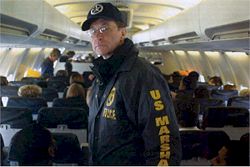
The Marshals Service is responsible for apprehending wanted fugitives, providing protection for the federal judiciary, transporting federal prisoners (see JPATS), protecting endangered federal witnesses, and managing assets seized from criminal enterprises. The Marshals Service is responsible for 55.2 percent of arrests of federal fugitives. In 2007, U.S. Marshals captured over 36,000 federal fugitives and cleared over 38,900 fugitive warrants.[4]
The United States Marshals Service also executes all lawful writs, processes, and orders issued under the authority of the United States, and shall command all necessary assistance to execute its duties.
U.S. Marshals also have the common law based power to enlist any willing civilians as deputies. In the Old West this was known as forming a posse, although under the Posse Comitatus Act, they cannot use soldiers for law enforcement duties.
Lastly Title 28 USC Chapter 37 § 564. authorizes United States marshals, deputy marshals and such other officials of the Service as may be designated by the Director, in executing the laws of the United States within a State, may exercise the same powers which a sheriff of the State may exercise in executing the laws thereof.[5]
Organization
The United States Marshals Service is based in Arlington, Virginia, and, under the authority and direction of the Attorney General, is headed by a Director, who is assisted by a Deputy Director. USMS Headquarters provides command, control and cooperation for the disparate elements of the service.
Executives
- Director of the U.S. Marshals Service – John F. Clark
- Deputy Director of the U.S. Marshals Service – Brian Beckwith
- Chief of Staff – Sean Fahey
- Equal Employment Opportunity (EEO) – Joann Grady
- Office of Communications
- Office of Public Affairs (OPA) – Jeffrey Carter, Chief
- Office of Congressional Affairs (OCA) – Doug Disrud, Chief
- Office of General Counsel (OGC) – Gerald M. Auerbach
- Office of Inspection (OI) – William Snelson
- Administration Directorate – Chris Dudley, Associate Director
- Training Division – Marc A. Farmer, Assistant Director
- Human Resources Division (HRD) – David Anderson, Acting Assistant Director
- Information Technology Division (ITD) – Joe Briggs, Acting Assistant Director
- Management Support Division (MSD) – Diane C. Litman, Assistant Director
- Financial Services Division (FSD) – Edward Dolan, Assistant Director
- Asset Forfeiture Division (AFD) – Michael A. Pearson, Assistant Director
- Operations Directorate – Robert J. Finan II, Associate Director
- Judicial Security Division (JSD) – Donald Donovan, Acting Assistant Director
- Investigative Operations Division (IOD) – Mike Earp, Acting Assistant Director
- Witness Security Division (WSD) – Sylvester E. Jones, Assistant Director
- Justice Prisoner and Alien Transportation System (JPATS) – Scott C. Rolstad, Assistant Director
- Tactical Operations Division (TOD) – David Roberston, Acting Assistant Director
- Prisoner Operations Division (POD) – Candra S. Symonds, Assistant Director
Regional
The U.S. court system is divided into 94 Districts, each with a U.S. Marshal, a Chief Deputy U.S. Marshal (GS-15) (and an Assistant Chief Deputy U.S. Marshal (GS-14) in certain larger districts), Supervisory Deputy U.S. Marshals (GS-13) [6], and as many Deputy U.S. Marshals (GS-5 and above) [7] and Special Deputy U.S. Marshals as needed. In the US federal budget for 2005, funds for 3,067 deputy marshals and criminal investigators were provided. The US Marshal of a US Circuit Court is the US Marshal in whose district that court is located.
The Director and each United States Marshal is appointed by the President of the United States and subject to confirmation by the United States Senate. The District U.S. Marshal is traditionally appointed from a list of qualified law enforcement personnel for that district or state. Each state has at least one district, while several larger states have three or more.
Deputy U.S. Marshals
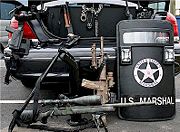
OPM Classification
Deputy U.S. Marshals are classified General Schedule (GS) 1811 Criminal Investigators,[8] or a basic 082 Deputy Marshals.[9] Deputy U.S. Marshals start their careers in a 3-year Deputy Development Program at either a GS-5 or GS-7 pay grade. After 1 year in grade they are promoted to GS-7 or GS-9. After another year, those at the GS-7 level are entitled to GS-9, while those at GS-9 move onto GS-9 Step 2. After completion of the Deputy Development Program, DUSM's reach GS-11. The paygrade ranks similar to that of a senior Police Sergeant or a Police Lieutenant. Criminal Investigators receive an additional 25% LEAP pay on top of their base pay, and will progress to the grade of GS-12 (approx. Police Captain or Police Deputy Chief). Automatic progression to the grade of GS-13 is in the works, and is hopeful for career Deputy U.S. Marshals in the near future.
There is no longer a disparity between job classifications within the United States Marshal Service. As of February 2007, all Deputy US Marshal new hires receive Criminal Investigator Training and Basic Deputy US Marshal training. However, until all previously hired 082's are trained and converted to 1811 Criminal Investigators, new hires are still classified as 082s. Full conversion of all 082's to 1811's is not expected until Fiscal Year 2010.
When DUSM's aren't out making street arrests, they can be found protecting government officials, seizing assets of major crime rings, relocating and providing new identities for witnesses in the federal witness protection program which is headed by the USMS. Through the Adam Walsh Act, the U.S. Marshals Service was chosen to head up the new federal sex offender tracking and prosecution hot team. Deputy U.S. Marshals make more street arrests than all other federal law enforcement agencies combined. [10]
Titles[11]
- United States Marshal -- for the top executive Marshal's Service position in a Federal judicial district.
- Chief Deputy United States Marshal -- for the position of principal subordinate to the U.S. Marshal for a Federal judicial district who is responsible for management of the Marshal's office and staff.
- Supervisory Deputy United States Marshal -- for positions in the Marshals Service responsible for the supervision of three or more deputy U.S. marshals and clerks.
- Deputy United States Marshal -- for all nonsupervisory positions classifiable to this series.
Special Deputy U.S. Marshals
The Director of the Marshals Service is authorized by (authorizing Director of Marshals Service to appoint "such employees as are necessary to carry out the powers and duties of the Service") to deputize the following individuals to perform the functions of Deputy Marshals: selected officers or employees of the Department of Justice; federal, state or local law enforcement officers; private security personnel to provide courtroom security for the Federal judiciary; and other persons designated by the Associate Attorney General". The first local law enforcement officer to be deputized was Officer William Shields of the Haverford Township Police department.
Court Security Officers
Court Security Officers,[12] are contracted former law enforcement officers who receive limited deputations as armed special deputy marshals and play a vital role in courthouse security. Using security screening systems, CSOs detect and intercept weapons and other prohibited items that individuals attempt to bring into federal courthouses. There are more than 4,700 CSOs with certified law enforcement experience are deployed at more than 400 federal court facilities in the United States and its territories.
Detention Enforcement Officer
DEO's (1802's) are responsible for the care of prisoners in USMS custody. They also are tasked with the responsiblity of conducting Administrative remedies for the US Marshal. DEO's can be seen transporting, booking and securing federal prisoners while in USMS custody. They also provide courtroom safety and cell block security.
Detention Enforcement Officers are Deputized as Federal Law Enforcement Officers by the US Marshal. They are authorized to carry firearms and conduct all official business on behalf of the agency. Not all districts employee Detention Enforcement Officers.
Line of duty deaths
More than 200 U.S. marshals, deputy marshals, and special deputy marshals have been slain in the line of duty since Marshal Robert Forsyth was shot dead by an intended recipient of court papers in Augusta, Georgia on January 11, 1794.[13] He was the first US Government Law Officer killed in the line of duty and the third policeman killed since the 1789 founding of the American Republic—the first being Constable Darius Quimby in 1791.[14] The dead are remembered on an Honor Roll permanently displayed at Headquarters.
Famous Marshals
Some famous or otherwise noteworthy U.S. Marshals include:
- Seth Bullock (1849–1919), businessman, rancher, sheriff for Montana, sheriff of Deadwood, U.S. Marshal of South Dakota
- Charles Francis Colcord (1859–1934), rancher, businessman and Marshal for Oklahoma
- Henry Dearborn (1751–1829), Marshal for the District of Maine
- Frederick Douglass (1818–1895), former slave and noted Abolitionist leader, appointed U.S. Marshal for the District of Columbia in 1877
- Virgil Earp (1843–1905), Deputy U.S. Marshal, Tombstone, Arizona
- Wyatt Earp (1848–1929), Deputy U.S. Marshal (appointed to his brother Virgil Earp's place by the Arizona Territorial Governor)
- Richard Griffith, Brigadier General in the Confederacy during the Civil War
- Wild Bill Hickock (1837–1876), noted Western lawman, who served as a Deputy U.S. Marshal at Fort Riley, Kansas in 1867–1869
- Bass Reeves (July, 1838 - January, 1910) is thought by most to be one of the first African Americans to receive a commission as a U.S. Deputy Marshal west of the Mississippi River. Before he retired from federal service in 1907, Reeves had arrested over 3,000 felons.
- Ward Hill Lamon (1826–1893), friend, law partner and frequent bodyguard of President Abraham Lincoln, who appointed him U.S. Marshal for the District of Columbia.
- Benjamin McCulloch (1811–1862), U.S. Marshal for Eastern District of Texas; became a brigadier general in the army of the Confederate States during the American Civil War
- Henry Eustace McCulloch (1816–1895), U.S. Marshal for Eastern District of Texas. Brother of Benjamin McCulloch; also a Confederate General
- James J. P. McShane (1909-1968), Appointed U.S. Marshal for the District of Columbia by President John F. Kennedy then named Chief Marshal in 1962
- John W. Marshall, U.S. Marshal for the Eastern District of Virginia (1994–1999), first African-American to serve as Director of the U.S. Marshals Service (1999–2001)
- Bat Masterson (1853–1921), noted Western lawman-Deputy to US Marshal for Southern District of New York-appointed by Theodore Roosevelt
- Joseph Meek (1810–1875) Territorial Marshal for Oregon
- Robert F. Morey, Marshal for Massachusetts, designed the USMS Seal. The Marshals Service is the only agency to have its seal created by one of its own.
- Thomas Morris (New York) (1771–1849), Marshal for New York District.
- Henry Massey Rector (1816–1899), Marshal for Arkansas, later governor of that state
- Porter Rockwell (c.1813–1878), deputy marshal for Utah
- William Stephens Smith (1755–1816), 1789 U.S. Marshal for New York district and son-in-law of President John Adams
- Dallas Stoudenmire (1845–1882), successful City Marshal who tamed and controlled a remote, wild and violent town of El Paso, Texas; became U.S. Marshal serving West Texas and New Mexico Territory just before his death
- Heck Thomas (1850–1912), Bill Tilghman (1854–1924), and Chris Madsen (1851–1944), the legendarily fearless "Three Guardsmen" of the Oklahoma Territory
- William F. Wheeler (1824–1894), Marshal for the Montana Territory
- James E. Williams (1930–1999), Marshal for South Carolina, Medal Of Honor recipient.
Fictional U.S. Marshals
- Anderson, James – voice acted by Jeff Osterhage, in the PC game Outlaws (1997).
- Beck, Steven - played by Forest Whitaker in the film "Witness Protection" (1999)
- Best, Sam – played by Joel Higgins, in the TV series Best of the West (1981–1982).
- Biggs, Bobby – played by Daniel Roebuck , in the films The Fugitive (1993) and U.S. Marshals (1998).
- Blake, Anita - from the series Anita Blake: Vampire Hunter
- Bonnet, Eli – from the 1996 novel, "Whispers of the River," by Tom Hron.
- Buckhart,Sam – Native American Marshall played by Michael Ansara in the NBC series Law of the Plainsman (1959–1960).
- Burch, Elias- played by Willie Nelson, in the TV series Dr. Quinn, Medicine Woman (1996-1998).
- Cahill, J. D. – played by John Wayne, in the film Cahill U.S. Marshal (1973).
- Cain, Sam – played by Brett Cullen, in the TV series The Young Riders (1989–1990).
- Deputy Marshal – played by Craig Reay (Cain's deputy).
- Carter, Jack – played by Colin Ferguson, in the TV series Eureka (2006–).
- Carter, Ray – played by Robert Patrick, as the head of the U. S. Marshal Service in the film Charlie's Angels: Full Throttle (2003).
- Cogburn, Reuben J. "Rooster" – played by John Wayne, in the films True Grit (1969) & Rooster Cogburn (1975), and by Warren Oates in a 1978 TV sequel
- Cooper, Jed – played by Clint Eastwood, in the film Hang 'Em High (1968).
- Cooper, Savannah – played by Latanya Richardson, in the film U.S. Marshals (1998).
- Craddock, Jack – played by Richard Comar, in the TV series Bordertown (1989).
- David – A minor character at the same a Marshal played by David U. Hodges in the film The Fugitive (1993)
- Deguerin, Robert – played by James Caan, in the film Eraser (1996).
- Dillon, Matt – played by William Conrad in the radio series (1952–1961) and by James Arness in the TV series (1955–1975) Gunsmoke.
- Drake, Eddie - played by Lee Tergesen, in the TV series Wanted (2005).
- Goode, Chester B. – played by Dennis Weaver (Dillon’s deputy).
- Haggen, Festus – played by Ken Curtis (Dillon’s deputy).
- Eckerson, Andy – played by Craig Bierko in the Law & Order: Special Victims Unit episode "Escape" (2003).
- Edward, aka Ted (Theodore) Forrester – from the series Anita Blake: Vampire Hunter
- Gerard, Samuel – played by Tommy Lee Jones, in the films The Fugitive (1993) and U.S. Marshals (1998).
- Gordon, Artemus – played by Kevin Kline, in the film Wild Wild West (1999). (Artemus Gordon was a Special Agent of the US Secret Service)
- Hamilton, Barnett – played by Monty Stuart (Hunter’s deputy).
- Henry – played by Johnny Lee Davenport , in the films The Fugitive (1993) and U.S. Marshals (1998).
- “the Highwayman” – played by Sam J. Jones, in the TV series The Highwayman (1987, 1988).
- Hunter, Teaspoon – played by Anthony Zerbe, in the TV series The Young Riders (1990–1992).
- Kane, Morgan – from the Morgan Kane Book series by Louis Masterson.
- Kane, Will – played by Gary Cooper in the film High Noon (1952).
- Kirkland, Lawrence - from the series Anita Blake: Vampire Hunter
- Kruger, John – played by Arnold Schwarzenegger, in the film Eraser (1996).
- Larkin, Vince – played by John Cusack, in the film Con Air (1997).
- La Roca, Jack – played by Lou Diamond Phillips, in the film Route 666 (2001).
- Long, Custis - fictional character in the Longarm western series
- MacBride, Winston – played by Jeff Fahey, in the TV series The Marshal (1995).
- Maddox, Jared – played by Burt Lancaster in the film Lawman (1970).
- Mann, Marshall - played by Frederick Weller in the TV Series In Plain Sight
- Mars, Edward – played by Fredric Lehne, in the TV series Lost (2004–2005).
- McCloud, Sam – played by Dennis Weaver, in the TV series McCloud (1970–1977).
- McQueen, Stan - played by Paul Ben-Victor, in the TV series In Plain Sight
- Morgan, Frank – played by John Bromfield, in the TV series Sheriff of Cochise (1956–1958) and U.S. Marshal (1958–1960).
- Newman, Noah – played by Tom Wood , in the films The Fugitive (1993) and U.S. Marshals (1998).
- O'Niel, W. T. – played by Sean Connery, in the film Outland (1981). (Note his badge at the end of U.S. Marshals Badges).
- Scanlon, Ike – played by Lee Van Cleef, in the TV Movie Nowhere to Hide (1977).
- Sisco, Karen – from the 1996 novel, Out of Sight, by Elmore Leonard. Played by Jennifer Lopez in the film Out of Sight (1998), and by Carla Gugino in the TV series Karen Sisco (2003–2004).
- Poole – played by L. Scott Caldwell , in the film The Fugitive (1993).
- Renfro, Cosmo – played by Joe Pantoliano , in the films The Fugitive (1993) and U.S. Marshals (1998).
- Shannon, Mary - played by Mary McCormack , in the TV series In Plain Sight (2008)
- Stetko, Carrie - from the 1998 comic series Whiteout by Greg Rucka and Steve Lieber, and its 2000 sequel. Played by Kate Beckinsale in the 2009 film adaptation.
- Stevens – played by Steve Baracella , in the film The Fugitive (1993)
- West, James – played by Robert Conrad on the T.V. series The Wild Wild West (1965) and by Will Smith, in the film Wild Wild West (1999). (James West was a Special Agent of the US Secret Service)
- White, Colton 'Cole' - from the Playstation 2, Xbox, and Xbox 360 game GUN.
- Wildhorse Dixon - from the novel, "Topaz", by Beverly Jenkins.
- Nessip, Pete - played by Wesley Snipes in the film Drop Zone
Fugitive programs
15 Most Wanted
The Marshals Service publicizes the names of wanted persons it places on the list of U.S. Marshals 15 Most Wanted Fugitives[15], which is similar to and sometimes overlapping the FBI Ten Most Wanted Fugitives list or the Bureau of Alcohol, Tobacco, Firearms, and Explosives Most Wanted List, depending on jurisdiction.[16]
(15 Most wanted website)[1]
The 15 Most Wanted Fugitive Program was established in 1983 in an effort to prioritize the investigation and apprehension of high-profile offenders who are considered to be some of the country’s most dangerous fugitives. These offenders tend to be career criminals with histories of violence or whose instant offense(s) pose a significant threat to public safety. Current and past fugitives in this program include murderers, sex offenders, major drug kingpins, organized crime figures, and individuals wanted for high-profile financial crimes.
Major cases
The Major Case Fugitive Program was established in 1985 in an effort to supplement the successful 15 Most Wanted Fugitive Program. Much like the 15 Most Wanted Fugitive Program, the Major Case Fugitive Program prioritizes the investigation and apprehension of high-profile offenders who are considered to be some of the country’s most dangerous individuals. All escapes from custody are automatically elevated to Major Case status.[17]
See also
- List of United States federal law enforcement agencies
- Marshal
- Sheriff
- Constable
- Federal police
- Justice Prisoner and Alien Transportation System
- Going Snake Massacre
- Fugitive Task Force
Notes
- ↑ "Fact Sheet: United States Marshals Service" (PDF). usmarshals.gov. Retrieved on 2007-01-08.
While the Postal Inspection Service's first agent (then called a "surveyor") was appointed in 1772, they were not organized as a service/agency until 1830. (Chronology: U.S. Postal Inspection Service) - ↑ "History in Custody: The U.S. Marshals Service Takes Possession of North Carolina’s Copy of the Bill of Rights". United States Marshals Service: Historical Perspective. usmarshals.gov. Retrieved on 2007-01-08.
- ↑ "U.S. Marshals make legal presence in Antarctica". United States Marshals Service: Historical Perspective. usmarshals.gov. Retrieved on 2007-01-08.
- ↑ http://www.usmarshals.gov/duties/factsheets/facts.pdf
- ↑ http://www.law.cornell.edu/uscode/uscode28/usc_sec_28_00000564----000-.htm
- ↑ POSITION CLASSIFICATION STANDARD FOR UNITED STATES MARSHAL SERIES, GS-0082
- ↑ POSITION CLASSIFICATION STANDARD FOR UNITED STATES MARSHAL SERIES, GS-0082
- ↑ Position Classification Standard for General Investigating/Criminal Investigating Series, GS-1810/1811
- ↑ POSITION CLASSIFICATION STANDARD FOR UNITED STATES MARSHAL SERIES, GS-0082
- ↑ http://www.fbi.gov/ucr/cius2006/arrests/index.html
- ↑ U.S. Office of Personnel Management 2 United States Marshal Series, GS-0082 TS-14 June 1973
- ↑ DOL WHD: SCA Occupation Directory - 27010 COURT SECURITY OFFICER
- ↑ Marshal Robert Forsyth, United States Department of Justice - Marshals Service
- ↑ http://www.odmp.org/officer.php?oid=16907 Constable Darius Quimby
- ↑ Current U.S. Marshals 15 Most Wanted Fugitives
- ↑ ATF Online - Bureau of Alcohol, Tobacco and Firearms
- ↑ Current U.S. Marshals Service Major Case Fugitives
External links
- U.S. Marshals Service
- Court Security Program - includes role in CSO's
- AUTHORITY OF FBI AGENTS, SERVING AS SPECIAL DEPUTY UNITED STATES MARSHALS, TO PURSUE NON-FEDERAL FUGITIVES
- DEPUTIZATION OF MEMBERS OF CONGRESS AS SPECIAL DEPUTY U.S. MARSHALS
- USC on the US Marshals Service
- Retired US Marshals Association
|
||||||||||||||||||
